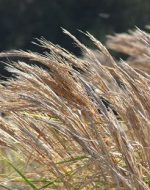 Also called whiskey grass, broomsedge is bunch grass native to southeastern US but has expanded its native range and can be found in the Midwest, Northeast, California and Hawaii. The common name, broomsedge, is misleading as the plant is not a sedge but a true grass and member of the Poaceae family that also includes bamboo, rice, and corn. Broomsedge grows well on infertile moderately moist soil in full sun and can be found in abandon sites and waste areas. It inhibits the growth of other plants by producing persistent herbicidal chemicals as it decomposes.
Also called whiskey grass, broomsedge is bunch grass native to southeastern US but has expanded its native range and can be found in the Midwest, Northeast, California and Hawaii. The common name, broomsedge, is misleading as the plant is not a sedge but a true grass and member of the Poaceae family that also includes bamboo, rice, and corn. Broomsedge grows well on infertile moderately moist soil in full sun and can be found in abandon sites and waste areas. It inhibits the growth of other plants by producing persistent herbicidal chemicals as it decomposes.
Description: Plants grow in tufts from 2-4′ tall with slightly flattened stems that branch toward the top. The stems and leaves are green at first, turning reddish brown before fading to straw-color as they persist into winter. The flowers appear in the fall through early winter and consist of two to four finger-like clusters with tufts of long white hairs. Seed production is very high, and both germination and seedling survival rate are high.
Control: Improving the soil fertility, especially the content of phosphorus and calcium, is one of the best ways to control broomsedge. Other strategies include removing plants before seed set by pulling, hoeing or digging, or covering the soil for a season with a dense mulch such as cardboard or newspaper. In extreme situation herbicides containing glyphosate can be effective but will kill any other vegetation it touches.